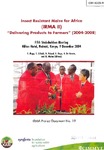| Abstract:
| The IRMA project is aimed at producing stem borer resistant and locally adapted maize for various Kenyan agro-ecological zones using conventional and biotechnology mediated methods, especially Bt technology. Transgenic maize containing Bacillus thuringiensis (Bt) is a focal point of the project, prompting project organizers to emphasize public involvement and awareness through events such as the Stakeholders Meeting. The IRMA project was publicly launched on March 3, 2000 with the convening of the first Stakeholders Meeting in Nairobi, Kenya. A stakeholder meeting is held every year leading to this fifth meeting held on 9 December 2004. The stakeholders have included: farmers' associations, women's groups, religious organizations, seed producers, regulatory agencies, NGOs, the media, consumer associations, food processors, project scientists from KARl, CIMMYT and participating and potentials donors. The specific objectives of the Stakeholders' Meeting have variously been to: 1. Introduce the IRMA project to stakeholders, 2. Create awareness on the economic importance of stem borers in Kenyan agriculture, 3. Create awareness on the control options for stem borers, 4. Solicit responses from stakeholders on the need and processes of developing insect resistant maize for Kenya 5. Inform the stakeholders on the progress as well as to review the progress, 6. Solicit feedback for the project scientists to direct their way forward 7. Visit the biosafety facilities that IRMA has developed at the KARl Biotechnology Center at NARL including the biosafety greenhouse complex and the biosafety levei II laboratory. In all these meetings, the stakeholders have expressed the need to use sound management strategies and to follow the national regulations strictly during introduction and testing of Bt genes in the country. The view shared by nearly all was that we could only evaluate Bt genes if they are in the country. Bt maize was viewed as having high chances of closing the wide and increasing food deficit in Kenya. During the more recent stakeholders meetings, participants expressed satisfaction with the progress of the project and suggested greater emphasis on training. The fifth stakeholders' meeting attracted 93 participants from 34 institutions that were categorized into eight groups. This was almost double the participation in 2003 by institutions as well as total number of participants. |

